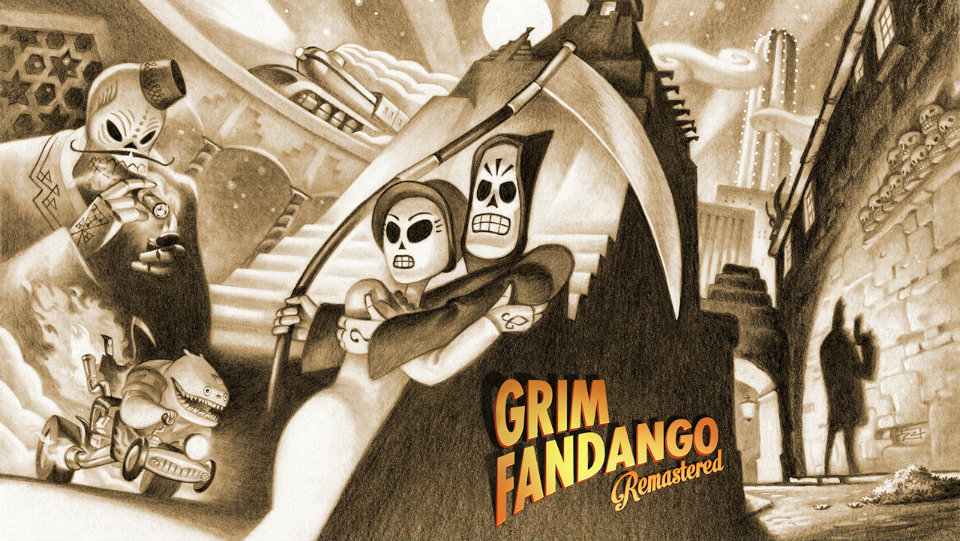Filtered by: Scitech
SciTech
Game review: Taking the skeletons out of the closet with Grim Fandango Remastered
By MATTHEW ARCILLA

Like any other cultural medium, video games are subject to changing moods and trends. Conventions and tropes that have grown comfortingly familiar are set aside for others, whether to appeal to evolving tastes or overcome lingering problems. But characters and stories — good ones that is — never go out of style. 'Grim Fandango' is one such example, and despite the darkness of its humor and the frustrations of adventure game habits, it is a warm and inviting experience that stands the test of time.
'Grim Fandango' was originally released in 1998, an interesting year that marked the beginning of the adventure genre's fading spotlight. While adventure games were famous for their stories and characters, their reliance on puzzles and conversations made for some stuffy experiences when compared to action and strategy games. Grim Fandango made up for that by bringing novelty in spades: a neo noir story set in a fully realized urban underworld inspired by the Mexican Day of the Dead.
As Manny Calavera, you're a salesman who reaps the souls of those who have passed on in the Land of the Living and then sells them a travel package to ease their journey into the Land of Eternal Rest. Manny hasn't been bagging premium clients lately, and the contempt of his cocksure rival Domino Hurley and his corrupt boss Don Copal are softened only by his wry sense of humor. When a saintly client can't even qualify for the lowliest of packages, Manny realizes a web of corruption and fraud lies at the heart of his troubles, and uncovering it takes him on epic journey across the Land of the Dead.
Unfortunately, despite LucasArts' famed production values, the pedigree of lead designer Tim Schafer and widespread acclaim from critics, 'Grim Fandango's sales were underwhelming. The company followed up with an unsurprisingly conservative Monkey Island sequel before terminating the rest of their adventure game slate. In the seventeen years since Grim Fandango's release, it has attracted a strong cult following thanks to a memorable jazz, bebop and swing soundtrack, distinctive art design and the charms of its protagonist.
True to company form, Disney Interactive's stewardship of the LucasArts portfolio — following the Walt Disney Company's acquisition of LucasFilm Entertainment in 2012 — has translated to a resurgence of interest in bringing its contents back to life. Not only is the LucasArts catalog gradually appearing at GOG.com but Disney Interactive is exploring ways to remaster old classics for modern gaming platforms. 'Grim Fandango Remastered' is the first such remastering — and launched earlier this week on Steam, GOG.com and PSN — to be followed by The Day of the Tentacle by the end of this year.
The resurrection of 'Grim Fandango' has been handled with the delicate touch of a museum restoration artist. Every single character asset has received textures with improved resolution, and light and shadow falls realistically on the now. The press of a button (or a keystroke) lets you see the difference between the remastered and the jaggy software rendered models of old. Unfortunately, the environmental backgrounds remain largely unchanged, and look disappointing next to the retextured models.
'Grim Fandango' was made before widescreen monitors were commonplace, so the game is presented in 4:3 aspect ratio with bars on the side to fill out the sides. You can choose to switch to a widescreen view if you insist on using all of the real estate on your screen, but that results in a stretched image. The soundtrack has been re-recorded by the Melbourne Symphony Orchestra, which also recorded the score to last year's 'Broken Age.' Most importantly, the 'Grim Fandango Remastered' retains everything that made it fresh in 1998: a stunning blend of Art Deco architecture, Aztec folklore, film noir storytelling and Latin-influenced music that stands out even today.
Originally, you steered Manny using your keyboard and joystick, as if he were some skeletal bipedal vehicle, but 'Grim Fandango Remastered' adds a more conventional point and click interface. I bought it for my wife on the Playstation Vita and that version also includes touch screen support. Simply put, everything has been done to make the game as playable as possible for different kinds of players on different platforms.
That allows players to focus on the puzzle solving. Some of them can be obtuse, but they are never needlessly complex. 'Grim Fandango' is pretty clear at giving player's objectives and throwing simple obstacles in the way of fulfilling them. Where it stumbles is its exploration: the world consists of fixed camera angles of various environments, but too often there is a corner you might miss if you don't step in precisely the right direction or angle. The lack of a built-in hint system — such as the 'Smart Alex' in last year's 'Tesla Effect', or the hint key from 'Monkey Island 2: Special Edition' — means that stumped players will turn to the Internet (or in my wife's case, a spouse with a good memory for 15 year old adventure games) for help.
The most welcome addition to the game is the developer commentary. While 'Grim Fandango Remastered' is far from the first game to incorporate commentary, it's a rare enough feature to be worth noting, and one that merits inclusion in any video game of technical, cultural or artistic significance, or at least with pretensions of such. Accompanying Schafer are composer Peter McConnell, lead artist Peter Chan, and programmer Bret Mogilefsky among others.
All things being said, while the technical work that has gone into making 'Grim Fandango Remastered' accessible once more to the current generation is quite the accomplishment, the fact is that you don't need rose tinted glasses to appreciate it. Seventeen years later, 'Grim Fandango's place as one of the finest adventure games ever made is not only re-established, it serves as a reminder that classics can never be truly interred with their bones. — TJD, GMA News
More Videos
Most Popular




